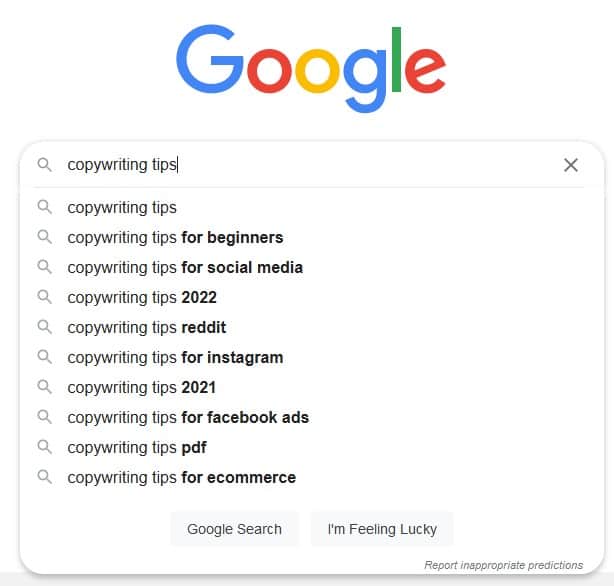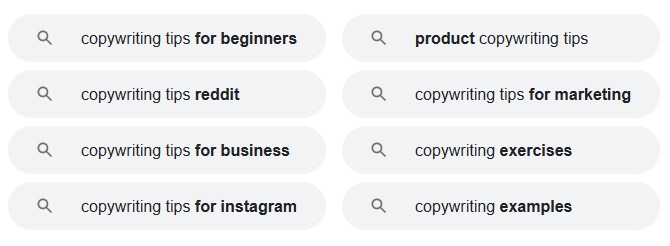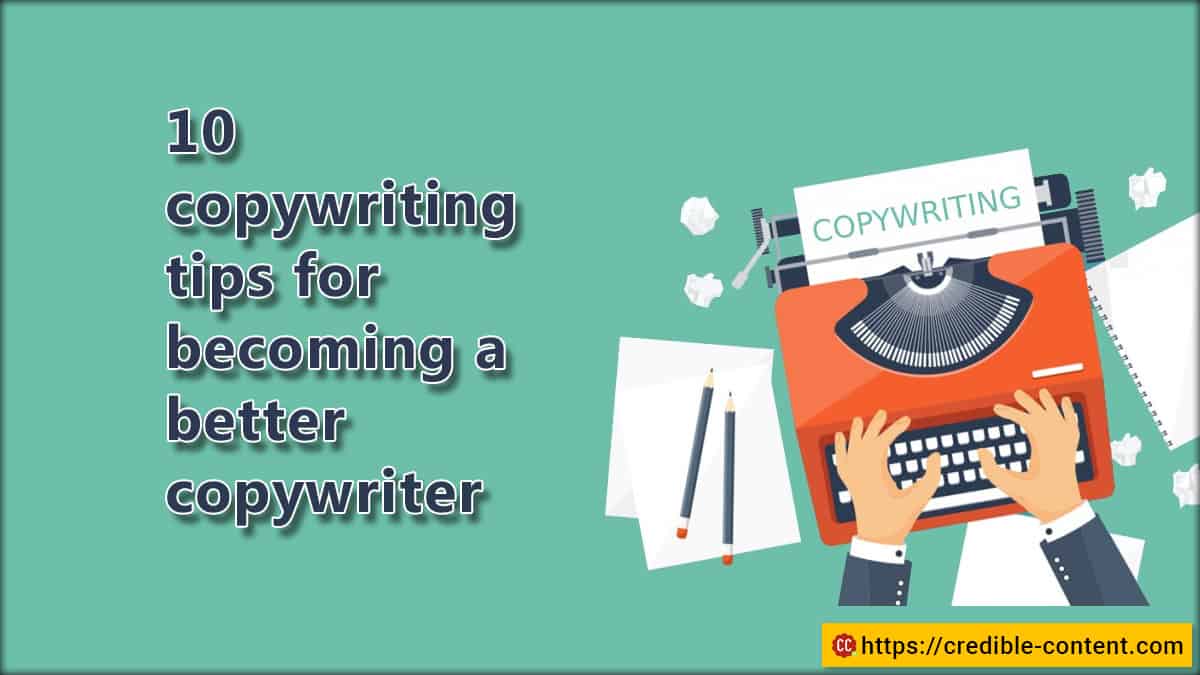Want to become a better copywriter instantly? These copywriting tips can help you.
10 copywriting tips explained in this blog post include:
- Learn to write irresistible headlines
- Write for search intent
- Make an emotional connection
- Write short sentences and paragraphs
- Avoid using jargon and difficult words
- Research your topic thoroughly
- Focus on advantages and deliverability
- Make every sentence count
- Be open to editing and revising
- Don’t obsess over SEO
Copywriting is a term that is heavily used in advertising.
The writers who write marketing literature and advertisements are called copywriters.
But these days the term is also used for writers who write for websites and blogs.
That’s because just like in advertisements, when you are writing for your website or business blog, you need to convert visitors into paying customers and clients.
In fact, whenever you write to convince, whether it is a web page, a landing page, a blog post, a case study, or an email, you are doing copywriting.
You are writing to convince.
In that sense, everyone who writes to convince, is a copywriter.
You may like to read: 13 copywriting rules I use when writing copy for my clients
What is the difference between copywriting and content writing?
Content writing is mostly informational writing.
Of course, you need to write well.
Even in content writing conversion matters.
But content writing is mostly done to provide educational and informational content to the visitors so that they have a reason to visit your website or blog repeatedly.
Content writing is extensively used for SEO purposes.
Copywriting, along with informing and educating, also sells.
It has a clear call-to-action.
The end purpose of a piece of copywriting is to sell or to achieve the call-to-action.
Your call-to-action doesn’t always have to be selling.
It can be downloading an e-book.
It can be subscribing to your newsletter.
It can be signing up for a seminar.
It can be using a free product.
Whatever you want to achieve to establish a long-term relationship with your prospective and existing customers and clients, comes in the ambit of call-to-action.
Good copywriting skills are essential for
- Clearly communicating your brand message.
- Improving your CTR (click through ratio).
- Engaging visitors in a constructive manner.
- Creating value driven content.
- Improving search engine rankings (in the context of writing for websites and blogs).
- Attracting more visitors to your website and blog.
- Keeping your prospective customers and clients proactively engaged in the long-term.
Want to become a better copywriter instantly?
Here are 10 copywriting tips you can implement instantly.
1. Learn to write irresistible headlines
It is your headline that draws people to your remaining text.
When I talk about headlines, I refer to the title of your web page or blog post, the main headline that appears at the top of your web page or blog post, and in the context of writing emails, your subject line.
These are highly important pieces of content.
The web page or the blog post title is called the meta title.
It shows up in search results.
If it is not captivating, if it does not convey the right message, people don’t click your link.
If they don’t click your link, they don’t come to your web page, and if they don’t come to your web page, there is a little chance of them becoming paying customers or clients.
You may like to read: 8 types of headlines you can use in copywriting
There is a reason why sometimes I differentiate between the meta title, the headline and the email subject line.
Your meta title must be less than or equal to 60 characters because this is the length that appears on Google search results.
With the headline there is no such restriction.
The headline appears on your own page.
You can make it as long as you want.
The same goes for the email subject line.
You cannot have a very long email subject line because then it won’t fit in the inbox preview panel.
For meta title and email subject line, your headline must be as few characters as possible, and at the same time, contain the main phrase.
For example, the main title of this blog post contains “copywriting tips” because this is the main intention of this blog post.
Here are a few things to keep in mind when writing your headline
- Include the phrase that represents your subject matter.
- Include the hook (become a better copywriter).
- Use simple, positive language.
- Be provocative.
- Use Power words.
- Make an emotional connection.
2. Write for search intent
Search intent is the intention with which your target readers search Google (or any other search engine).
Are they simply looking for information?
Do they want to navigate to a website?
Do they want to do research before purchasing something or subscribing to a service?
Do they want to purchase a certain product and for that, they’re looking for more information?
All these are different intentions.
You may want to read: How effective content writing and searcher intent are interrelated
Even subtle differences can send your copywriting efforts to an entirely different direction that you don’t want to pursue.
Whether you are copywriting for yourself or for your client, carefully understand the search intent you want to target and then write accordingly.
This will help you become a more effective and better copywriter.
For example, what search intent am I targeting through this blog post?
I am targeting people who are searching for copywriting tips with an intention of becoming better copywriters.
3. Make an emotional connection
It is suggested that power words be used for making emotional connection through copywriting.
This Entrepreneur article claims that research has shown that adds that touch readers’ emotions are more successful than adds that touch their intellect.
The same applies to copywriting.
Most, if not all, buying decisions are emotion-based.
In terms of copywriting, emotions can be divided into 6 broad categories:
- Loyalty
- Confidence
- Fear
- Anger
- Curiosity
- Greed
You must have come across samples of copywriting that offer you a “bargain” or a “cheap” offer, or promising to “double your investment”.
These are all appealing to your greedy side.
Words such as “sneak peek”, “top secret”, “members only”, and “classified” make you curious.
Visit this Optinmonster link to go through 700 power words that you can use to make an emotional connection through your copywriting.
They have categorized these words under basic emotions such as curiosity, greed, anger, lust, vanity, and so on.
4. Write short sentences and paragraphs
This is particularly important when you are copywriting for web, and I have observed I have mentioned this copywriting tip in almost every blog post on the subject.
Short and simple sentence is also good for your SEO.
Although search engine algorithms are becoming quite advanced, it is still difficult for them to analyse compound and complex sentences.
Simple sentences are easier to analyse.
They help you improve your search engine rankings.
Your readers also find reading small sentences easier and meditative.
The same goes for paragraphs.
You must have noticed on some websites that they have single-sentence paragraphs.
They may seem odd in the beginning, but after a while, you find that they are easier to read.
Especially on mobile phones.
These days all my paragraphs are single-sentence.
If you find it odd, at the most, use two sentences in a paragraph.
Not more.
Remember that many people read your copy on their mobile phones.
Even marginally big paragraph will cover half the screen.
This can be distracting and intimidating.
Short sentences, divided in short paragraphs make it easier to read on mobile phones.
5. Avoid using jargon and difficult words
Again, I have written about this copywriting tip multiple times.
Jargon is a set of industry-specific words.
Jargon words are known to people within a profession, or an industry and they are mostly not known to the outsiders.
My rule of thumb is, use jargon words when you are copywriting for B2B purposes and avoid using them when you are writing for B2C.
When visiting technology websites, you must have come across expressions like “paradigm shift”, “bleeding edge” and “bandwidth”.
As much as possible, avoid using such clichés.
As a trained copywriter your vocabulary is much better than an average person.
If you understand “ubiquitous” it doesn’t mean that the person reading your copy also understands the word.
Use common words.
Do some research on Google to find out what type of search queries people submit and then use the language in those search queries.
 In the above screenshot, as you can see that when I partially enter copywriting tips without hitting the enter key, Google gives me the suggestions of the search queries people normally use after copywriting tips.
In the above screenshot, as you can see that when I partially enter copywriting tips without hitting the enter key, Google gives me the suggestions of the search queries people normally use after copywriting tips.
In the below screenshot, after hitting the enter . Key, when I scroll to the bottom of the Google search results page, it gives me the suggestions of the search queries people often use with “copywriting tips”.
 Such research can help you decide what words to use when writing copy.
Such research can help you decide what words to use when writing copy.
6. Research your topic thoroughly
The more you research, the more convincing will be your copywriting.
When you are writing about the product, read about it as much as possible.
Read about the competitors.
Read why competitors are better.
Read why the product you are writing about is better than the competitors.
Study the customer profiles.
Gather industry data.
Although I’m giving the suggestions, I also understand that if you are writing for a client, every client has a limited budget and you cannot spend much time on research.
But if you are writing for your own website, leave no stone unturned.
Don’t assume that you know everything about your target audience.
7. Focus on advantages and deliverability
Trained and experienced copywriters focus on the benefits and what the product delivers rather than on its features.
This Hubspot post describes the difference between features and benefits nicely.
You may say that this headphone is wireless – this is a feature.
What is the benefit?
No more tangled cords.
You may say that an air fryer comes with a removable basket – this is a feature.
The benefit is that it is easier to clean after using.
No matter how great the set of features are in a product, ultimately, it is a set of benefits that prompts people to buy a product.
People don’t subscribe for a tool like Grammarly because it may have 50 features; they subscribe to it because they don’t want to commit grammar and structural mistakes and be embarrassed because of that.
How does your product or service make a consumer’s life easy?
I’m not saying completely ignore the features, but when copywriting, give more stress to benefits and what your product or service delivers.
8. Make every sentence count.
In many copywriting books you will read:
The job of your main headline is to make people read the first sentence of your first paragraph.
The job of the first sentence of the first paragraph is to make people read the second sentence of your copy.
This goes on.
Every sentence has a purpose: make the reader read the next sentence.
Just as every sentence has the capability to draw your readers into your copy, every sentence can also send your visitors away by making them feel clueless and directionless.
Therefore, get rid of sentences that are not needed.
Don’t say something repeatedly just to increase the word count.
Make every sentence special.
9. Be open to editing and revising
Most of the word processors these days do half the proofreading for you.
They can catch spelling mistakes.
They can catch grammar mistakes.
They even tell you if there is no subject verb agreement.
Hence, when I say that you should revise and proofread what you are writing, I’m talking about the structure and flow of your document.
Can sentences be shortened?
Can you include more data?
Can you remove difficult and redundant words?
Can you move chunks of text up or down for better flow?
Can you remove portions that are not needed?
Can you add another subheading?
All these things can be taken care of during editing and revising.
10. Don’t obsess over SEO
SEO copywriting is essential.
It means striking a balance between writing for search engines and writing for humans.
Mistakenly, many copywriters get carried away with writing for search engines and in the process, completely ignoring the human readers.
Write for your human readers first.
It doesn’t mean you ignore your keywords.
Throughout this post I have used the main keywords for the post: “copywriting tips” and “better copywriter”.
The new Google “Helpful Content” update algorithm is going to penalise websites that focus more on search engine optimization and less on publishing relevant, human centric and helpful content.
You should write human-centric copy not just because Google demands that, it is also important for your conversion rate.
Unless your copywriting makes an impact that positively affects people, you can’t become a better copywriter.
These are some copywriting tips that can help you become a better copywriter within a few hours.
You can also implement some long-term practices that will help you develop as a copywriter gradually, such as
- Develop the habit of knowing your product thoroughly.
- Practice copywriting every day.
- Learn from the masters and other prominent copywriters.
- Understand the industry for which you write your copy.
- Focus more on people and less on your copywriting style.
- Empathise with the readers.
- Read good books on copywriting.

